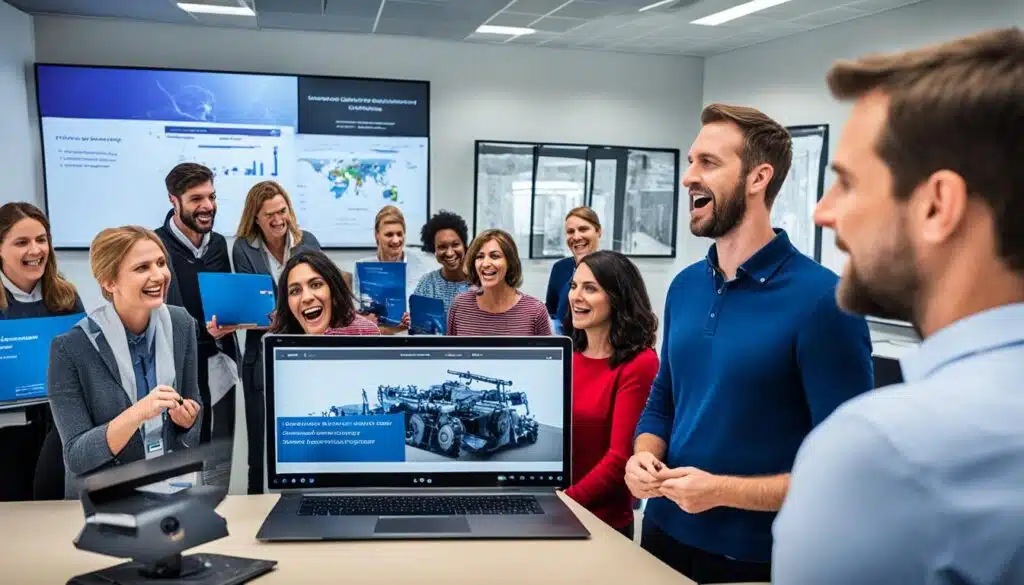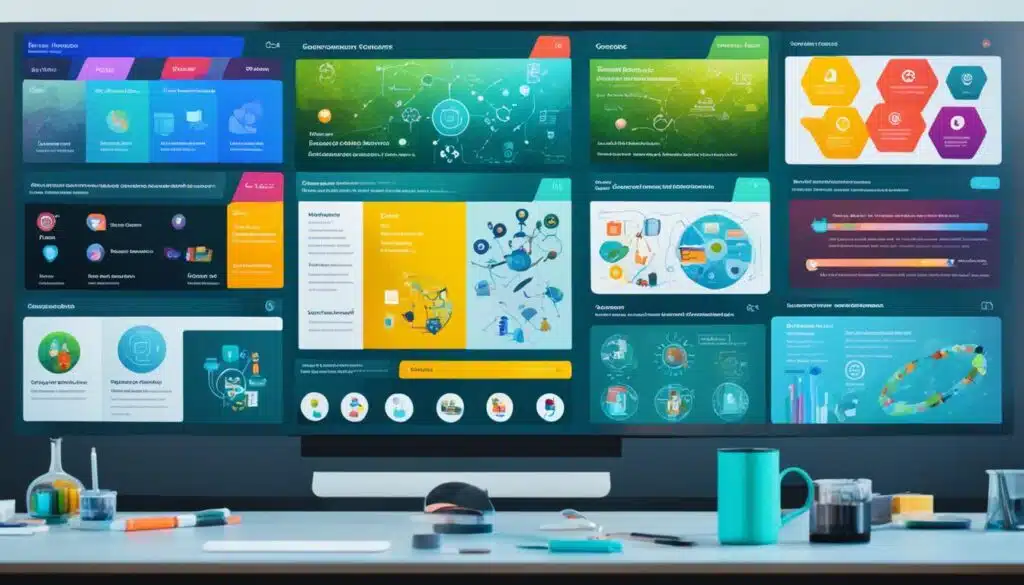Table of Contents
ToggleOnline lectures have revolutionized the way students access educational content. Gone are the days of sitting in a crowded classroom, furiously taking notes while trying to keep up with a fast-paced lecture. Instead, students now have the flexibility to learn at their own pace, anytime and anywhere.
Engaging online lectures go beyond simply presenting information. They incorporate interactive content and expert insights that elevate the learning experience. These lectures captivate students’ attention, encourage active participation, and facilitate a deeper understanding of the subject matter.
In this article, we will explore the importance of creating engaging lectures online and provide actionable tips and techniques for educators to make their lectures more interactive and effective. Whether you’re a student eager to enhance your learning journey or an educator looking to elevate your teaching methods, this article has something for everyone.
Key Takeaways:
- Online lectures provide students with the flexibility to learn at their own pace.
- Engaging online lectures incorporate interactive content and expert insights.
- By creating engaging lectures, educators can facilitate a deeper understanding of the subject matter.
- Students can enhance their learning journey by actively participating in interactive online lectures.
- This article provides actionable tips and techniques for creating engaging online lectures.
The Unique Features of Online Lectures
Online lectures offer several unique features that distinguish them from traditional face-to-face lectures. While both types of lectures involve teaching and learning, online lectures provide distinct advantages that cater to the diverse needs of students and educators.
One notable feature of online lectures is the flexibility in learning pace. Unlike face-to-face lectures, where students must adhere to a predetermined schedule, online lectures allow learners to set their own pace and progress through the material at a speed that suits their individual learning style and preferences.
Additionally, online lectures offer the convenience of being able to download the lecture content for offline viewing. This feature allows students to access the lectures even without a stable internet connection, enabling uninterrupted learning regardless of location or circumstances.
Another advantage of online lectures is the ability to control the playback speed. This feature is particularly beneficial for students who prefer a faster or slower pace of delivery. By providing options to adjust the playback speed, online lectures accommodate different learning preferences and promote a more personalized learning experience.
Online lectures can be further categorized into asynchronous and synchronous formats. Asynchronous lectures allow students to access the content at any time convenient for them, without the need for real-time interaction. This flexibility is especially advantageous for individuals with busy schedules or those in different time zones.
On the other hand, synchronous lectures facilitate real-time interactions between students and instructors. These live sessions enable immediate feedback, foster student engagement, and promote collaborative learning experiences. Synchronous lectures emulate the interactive nature of face-to-face classes, offering students the opportunity for real-time discussions and interpersonal connections.
Educators designing online lectures should consider these unique features and tailor their approach to create engaging and effective learning experiences for their students. By leveraging the advantages of asynchronous and synchronous lectures, educators can provide a dynamic and adaptable learning environment that caters to diverse learning needs and enhances student engagement.
“Online lectures offer flexibility in learning pace, the ability to download lectures for offline viewing, and the option to control the playback speed. Asynchronous lectures allow students to learn at their convenience, while synchronous lectures enable real-time interactions.”
As we can see, online lectures utilize a variety of features to ensure an immersive and effective learning experience. The next section will delve into the strategies for designing engaging online lectures that maximize student engagement and optimize learning outcomes.
Also Read : Exploring Benefits of Secondary Education
Designing Engaging Online Lectures

When designing online lectures, it is important to capitalize on the unique advantages of online teaching instead of simply replicating face-to-face courses. Online learning offers learners the flexibility to learn at their own pace and the convenience of accessing lectures at their preferred times. To create engaging online lectures, it is crucial to consider learner preferences and incorporate multimedia elements that facilitate effective learning.
Multimedia learning, which combines various forms of media such as text, images, audio, and video, is an effective approach in online education. By incorporating visuals and interactive content, educators can enhance student engagement and understanding. Effective visuals, such as diagrams, charts, and infographics, can convey complex information more efficiently than text alone. When using visuals, it is important to ensure that they are aligned with the content and provide a verbal description for accessibility purposes.
Engaging online lectures should be designed based on an understanding of the unique features of online learning. Instead of relying solely on traditional teaching methods, educators should adapt their approach to take advantage of the online environment. This includes leveraging the flexibility of online teaching to cater to learner preferences and providing opportunities for active participation and interaction.
By incorporating interactive elements such as quizzes, polls, and breakout discussions, online lectures can become more dynamic and engaging. These activities encourage students to actively participate, reflect on the content, and collaborate with their peers. Incorporating opportunities for self-assessment and immediate feedback can also enhance the learning experience and reinforce key concepts.
Designing engaging and effective online lectures requires careful consideration of learner preferences, the use of multimedia elements, and the implementation of interactive activities. By leveraging the unique advantages of online teaching, educators can create engaging lectures that inspire and empower students in their learning journey.
Also Read : Unlock Your Future With An Education Degree
Advantages of Online Lectures
| Advantages | Description |
|---|---|
| Flexibility | Learn at one’s own pace and access lectures at convenient times. |
| Accessibility | Overcome geographical barriers and accessibility constraints. |
| Learner Preferences | Tailor lectures to cater to individual learning styles and preferences. |
| Multimedia Learning | Enhance learning through the use of visuals, audio, and interactive content. |
Visuals provided courtesy of online course “Engaging Online Teaching Techniques” by XYZ Online University.
Tips for Creating Engaging Online Lectures

When it comes to creating engaging online lectures, there are several key strategies to keep in mind. While it may be tempting to recreate the traditional classroom lecture experience, online learning provides an opportunity to experiment with different formats that can be more engaging for students. Podcasts, written commentaries, and other interactive mediums can offer a fresh perspective and recapture student interest.
One of the most important factors in creating an engaging online lecture is knowing your audience. By gathering data on students’ backgrounds and interests, you can tailor the content to their needs and preferences. Understanding who you are teaching allows you to provide relevant examples, real-world connections, and context that resonates with your students.
Another key aspect of creating engaging online lectures is keeping them short and focused. Cognitive overload can easily distract students, so it’s best to keep lectures around 7-10 minutes. This helps maintain their attention and ensures that they can fully absorb the material being presented.
Authenticity is also crucial in online lectures. Allowing your personality to shine through creates a sense of belonging and connection with students. By being yourself, you can build rapport and establish a comfortable learning environment for all learners.
Integrating interactive elements into your lectures is another effective way to keep students engaged. Quizzes, breakout discussions, and other participatory activities encourage active learning and provide students with opportunities to apply their knowledge. These elements also foster collaboration and create a sense of community among students.
Lastly, the strategic use of visuals can greatly enhance the learning experience in online lectures. Incorporating relevant images, diagrams, and graphs can help reinforce the lecture content and improve student comprehension. Visuals are especially useful when explaining complex concepts or data.
By following these tips for creating engaging online lectures, educators can elevate the learning experience for their students. Remember to be creative, know your audience, keep lectures short, be authentic, include interactive elements, and use visuals strategically. By doing so, you will create a dynamic and effective online learning environment.
Also Read : Top 20 Educational Tools for Engaging Learning Experiences
Effective Lecture Structure and Delivery

An effective lecture structure and delivery are crucial for engaging students. Creating a clear structure with a logical flow helps students follow the content and grasp the main concepts. Incorporating engaging activities and promoting student participation, such as group discussions and interactive exercises, fosters active learning and deeper understanding. Emotional engagement is also important, and incorporating elements that trigger positive emotions, such as gamification or creative activities, can make lectures more memorable and impactful.
When designing the structure of an online lecture, consider breaking it down into clear sections or modules, each focusing on a specific topic or learning objective. This helps students navigate the content and ensures a coherent flow of information. Using informative headings and subheadings can further aid in organizing the lecture and allow students to locate specific information easily.
“A well-structured lecture creates a roadmap for students, guiding them through the learning journey and making the content more digestible.”
Engaging activities play a key role in keeping students actively involved in the learning process. These activities can include interactive polls, virtual simulations, case studies, or collaborative projects. By incorporating such activities, you provide opportunities for students to apply their knowledge, critically think, and engage with their peers. This active learning approach helps students establish a deeper understanding of the subject matter and promotes higher retention of information.
Student participation is essential for a successful lecture. Encourage students to ask questions, contribute their insights, and share their experiences related to the lecture topic. In addition to fostering a more inclusive learning environment, student participation allows for a diverse range of perspectives and encourages peer-to-peer learning.
Emotional engagement is a powerful tool for creating memorable and impactful lectures. Incorporating elements that trigger positive emotions, such as storytelling, humor, or thought-provoking examples, can help captivate students’ attention and make the lecture content more relatable and meaningful. Consider using multimedia resources like images, videos, or audio clips to enhance the emotional appeal of the lecture.
Also Read : Earn Your Early Childhood Education Degree Online
Example Engagement Activities:
- Group discussions or breakout rooms for collaborative learning
- Virtual simulations or case studies to apply theoretical concepts
- Real-life examples or anecdotes to make the content relevant
- Quizzes or polls for interactive assessments
- Role-playing exercises or debates for active participation
By structuring your lecture effectively, incorporating engaging activities, encouraging student participation, and fostering emotional engagement, you can create a dynamic and impactful learning experience for your students.
| Benefits of Effective Lecture Structure and Delivery | How It Supports Student Engagement |
|---|---|
| Clear structure with logical flow | Helps students follow the content and grasp the main concepts |
| Engaging activities | Promotes active learning and deeper understanding |
| Student participation | Fosters diverse perspectives and peer-to-peer learning |
| Emotional engagement | Makes lectures memorable and relatable |
Overcoming Engagement Challenges in Online Lectures
Engaging students in online lectures can be challenging due to the loss of visual cues and non-verbal communication. Without being physically present in the same room, it becomes harder for students to actively participate and engage with the content. Additionally, some students may lack confidence in speaking up or putting their views forward in an online environment, feeling exposed to judgment or criticism.
The fear of social risk further hinders student engagement, as students may feel hesitant to actively participate in discussions or ask questions. These challenges can result in low engagement levels and hinder the effectiveness of online lectures.
Also Read : Different Types Of Government Jobs In USA
To overcome these obstacles, educators can implement several strategies:
- Provide clear expectations: Clearly communicate participation expectations and norms to students. This helps create a supportive and inclusive learning environment where students feel more comfortable contributing.
- Create low-risk activities: Design activities that encourage participation without the fear of judgment or negative consequences. For example, use anonymous polling or discussion boards to foster open and non-threatening communication among students.
- Offer positive feedback: Recognize and acknowledge student contributions, even if they are not always correct. Positive feedback builds confidence and encourages active engagement.
To manage low engagement in online lectures, it is important to create an environment that supports student participation and reduces barriers to engagement. By implementing these strategies, educators can empower students to overcome their lack of confidence, feel more comfortable in expressing themselves, and actively engage in online lectures.
“Creating a supportive and inclusive learning environment is key to encouraging active participation and reducing the social risks associated with online lectures.” – Dr. Emily Johnson, Education Specialist
By addressing the challenges of loss of visual cues, lack of confidence, feeling exposed, and social risk, educators can create engaging online lectures that promote active participation and enhance the learning experience for all students.
Expert Tips for Engaging Online Lectures

Gaining insights from experts is invaluable when it comes to enhancing the quality and effectiveness of online lectures. By incorporating their expertise, educators can create engaging learning experiences that promote active student engagement and foster deeper learning.
Showcase Your Expertise
One of the expert tips for creating engaging online lectures is to showcase your expertise by sharing personal experiences and anecdotes related to the lecture content. This not only demonstrates your knowledge in the field but also adds a personal touch that resonates with students, making the learning experience more relatable and enjoyable.
Structure Lectures Clearly
A clear lecture structure with a logical flow is essential for keeping students engaged and facilitating their understanding of the content. Organize your lectures in a way that builds upon previous concepts and gradually introduces new information. This helps students follow the learning progression and connect different ideas more effectively.
Incorporate Interactive Activities
Adding interactive activities to your online lectures is another way to make them engaging and memorable for students. Encourage student interaction by asking questions, allowing time for discussion, or incorporating group activities. This fosters a sense of participation and collaboration, creating a dynamic learning environment that promotes deeper understanding.
Offer Opportunities for Feedback
Providing opportunities for feedback, even for incorrect answers, is crucial in engaging students and guiding their learning journey. Feedback helps students understand their progress, identifies areas for improvement, and motivates them to continue actively participating in the learning process. Consider using quizzes, assignments, or open discussions to encourage feedback and dialogue.
Expert Tip: “By incorporating personal experiences, structuring lectures clearly, integrating interactive activities, and offering feedback, educators can create engaging online lectures that foster deeper learning and student engagement.” – Dr. Sarah Johnson, Online Education Specialist
Implementing these expert tips in your online lectures will significantly enhance the learning experience for students. Remember to share your expertise, structure lectures clearly, incorporate interactive activities, and offer feedback to create engaging and impactful learning experiences.
| Expert Tips for Engaging Online Lectures |
|---|
| Showcase your expertise |
| Structure lectures clearly |
| Incorporate interactive activities |
| Offer opportunities for feedback |
Online Lecture Resources and Courses

Educators looking to create engaging online lectures can take advantage of various online courses and resources. These valuable resources provide insights, techniques, and guidance for enhancing student engagement, designing interactive activities, and implementing effective teaching methods. By exploring these resources, educators can improve their online lecture delivery and make the learning experience more impactful and engaging for students.
Engagement Techniques
- Utilize interactive tools and platforms to promote student participation and collaboration.
- Incorporate multimedia elements such as videos, images, and audio to enhance the learning experience.
- Create interactive quizzes and assessments to assess student understanding and engagement.
- Implement discussion forums or chat platforms to facilitate student interaction and peer-to-peer learning.
Teaching Methods
- Adopt a learner-centered approach that focuses on individual student needs and preferences.
- Implement active learning strategies, such as problem-solving activities and group projects.
- Use a flipped classroom model, where students review lecture materials before class and engage in discussions and activities during class time.
- Provide personalized feedback and guidance to students to promote continuous improvement.
Implementing these engagement techniques and teaching methods can significantly enhance online lectures and foster a dynamic and interactive learning environment.
Online lecture resources and courses offer a wealth of knowledge and support for educators seeking to create engaging online learning experiences. By leveraging these resources and incorporating effective engagement techniques and teaching methods, educators can create online lectures that captivate their students and maximize their learning potential.
Also Read : Secure Your Future With A Graduation Diploma
Conclusion
Engaging online lectures play a vital role in promoting effective learning and student engagement. By incorporating interactive content and utilizing effective teaching techniques, educators can create online lectures that enhance the learning experience for students. The tips and strategies shared in this article serve as a valuable guide for educators seeking to create impactful and memorable online lectures. These include tailoring the lecture structure to promote active participation, using multimedia elements to reinforce key concepts, and fostering a supportive learning environment.
By embracing interactive content, such as quizzes, discussions, and breakout activities, educators can keep students actively engaged and foster deeper understanding. Furthermore, providing timely feedback and opportunities for student interaction fosters a sense of inclusion and enhances the overall learning experience. It is important for educators to continually explore and implement innovative techniques that promote effective learning and student engagement in online lectures.
In conclusion, engaging online lectures that incorporate interactive content are instrumental in fostering effective learning and student engagement. By leveraging effective teaching strategies and creating a supportive learning environment, educators can create online lectures that resonate with students and promote active participation. As technologies and online learning platforms continue to evolve, staying updated on the latest trends and incorporating these into online lectures will further enhance the learning experience for students.
FAQs
Q: What is the meaning of a lecture?
A: A lecture is a formal speech or discourse given to an audience or class, especially for instruction.
Q: How can lectures be engaging for students?
A: Lectures can be engaging for students when the teacher uses graphic materials, quotes, bullet points, and other interactive tools to complement the speech.
Q: How can I cite a lecture in my academic work?
A: You can cite a lecture by mentioning the speaker, the date and location of the lecture, and any relevant information needed for proper referencing.
Q: Is it necessary to attend lectures in person for effective learning?
A: With the availability of online sources and software tools, attending lectures in person is not always necessary for effective learning. Online lectures can also be engaging and informative.
Q: Who can benefit from engaging lectures online?
A: Both students and faculty can benefit from engaging lectures online. Students get the opportunity to engage with the course material, while faculty can deliver content more effectively.
Q: What are some popular online platforms for accessing engaging lectures?
A: Platforms like Merriam-Webster, Edward Tufte, and other educational websites offer engaging lectures and resources for students and educators.
Q: How can engaging lectures improve student learning?
A: Engaging lectures can improve student learning by encouraging students to engage with the material, ask questions, and participate actively in the learning process.
Q: What is the definition of a lecture?
A: A lecture is a formal presentation or speech given to teach, inform, or inspire an audience on a particular subject.
Q: Can you explain the difference between a noun and a verb in a lecture context?
A: In a lecture, a noun is a person, place, thing, or idea, while a verb is an action or state of being.
Q: How can I find synonym options to use in my lecture?
A: You can use a thesaurus to find synonyms of words to enhance your lecture content.
Q: What role does sentence structure play in a lecture?
A: Sentence structure in a lecture is crucial for conveying information clearly and effectively to the audience.
Q: Where can I find the definition of a specific word used in a lecture?
A: You can refer to a dictionary to find the definition of any word you come across while preparing for a lecture.
Q: How can I make my lecture more engaging and interactive?
A: Using tools like quizzes, PowerPoint presentations, and real-life examples can help make your lecture more engaging for the audience.
Q: How can I cite a source in my lecture presentation?
A: You can cite your sources using proper referencing formats such as APA or MLA style to give credit to the original authors in your lecture.





